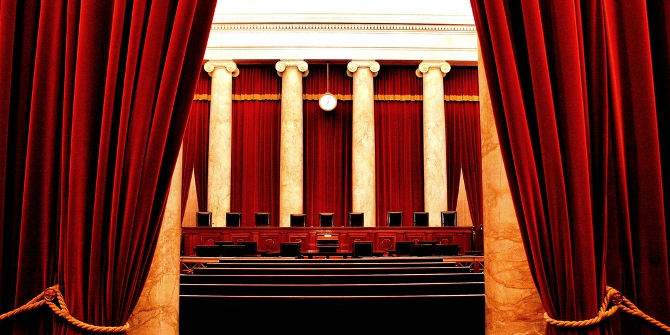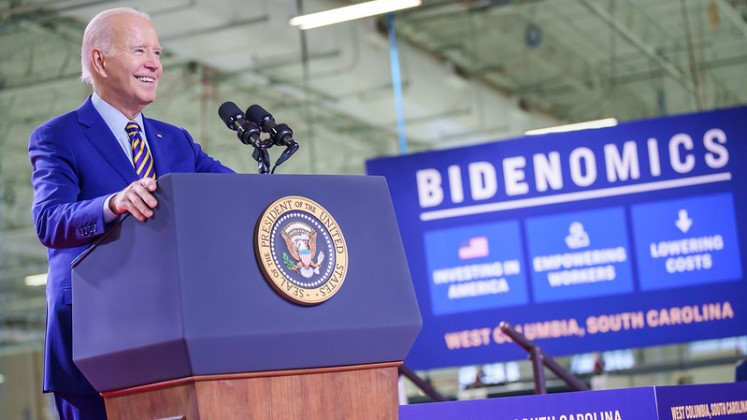From the presidential election to Donald Trump’s various trials, USAPP Managing Editor, Chris Gilson looks at the US political year ahead.
2024 has arrived, and with it the 60th United States presidential election. But before we get to election day on November 5th, what does the rest of the year have in store for US politics? Here’s what we know so far about what we can expect in the coming months and some background on why these events are important.
January – the US government budget, Biden impeachment enquiry, and the primaries begin
On January 7th, the US Congress – via Senate Majority Leader, Chuck Schumer (D-NY), and House Speaker, Mike Johnson, (R-LA) reached a budget deal to avoid a US government shutdown on January 19th. The “bipartisan appropriations agreement” sets spending to $1.59 trillion for the current fiscal year and needs to be passed by both the House and Senate ahead of January 19th when funding for some services runs out, and definitely by February 2nd, when funding for the remainder of government ends.
Staying in Washington DC, the US House Impeachment inquiry into President Joe Biden, focusing on the business dealings of his son, Hunter Biden, which was opened in December, will continue. As the inquiry develops this year, we can expect Republicans to continue with hearings, request information from Biden, issue subpoenas, and potentially kick off an impeachment trial in the Senate if the GOP-led house approves articles of impeachment.
This month will also see the first contests to select the Republican and Democratic presidential nominees. And while the election is being predicted by many to be a rematch of the 2020 race between Donald Trump and Joe Biden, a good deal could happen between now and the party’s nominating conventions in the summer. On the Democratic side, Joe Biden has attempted to reshape the party’s primary calendar to remove Iowa and New Hampshire’s influence on the nominating contest in favor of South Carolina, and to eliminate caucuses altogether. Biden was not entirely successful; Iowa is still holding a caucus from January 12th to March 5th, while the Granite State is still holding the first primary on January 23rd. There, the incumbent president is not actually on the ballot and will have to be a write-in candidate in order to avoid losing the state’s primary. Biden has several primary challengers, but none are expected to pose a significant threat to his re-nomination by the Democratic Party.
On the Republican side, Iowa will be holding its caucuses on January 15th and Iowa on January 23rd (at the same time as the Democratic Primary). According to the polls, Trump has a massive lead in Iowa over his closest Republican challengers, Florida Governor, Ron DeSantis and former South Carolina Governor, Nikkie Haley. Trump has less of a lead in New Hampshire; in the opening days of 2024, Nikki Haley has been gaining on Trump’s polling lead there, although the former president remains significantly ahead at this stage.
February – New York special election and the Supreme Court hears Trump’s 14th Amendment case
On February 13th there will be a special election to fill the US House seat (New York’s 3rd District) made vacant by the expulsion of Republican George Santos from Congress in December 2023. On the Republican side, the party’s candidate is Mazi Pilip, a member of the Nassau County Legislature. The Democratic candidate, Tom Suozzi, is a former member of Congress for the same district.
As 2023 came to an end, both Maine and Colorado barred former President Trump from their states’ primary ballots citing that he is disqualified from running for office under the 14th Amendment, because of his role in the January 6th 2021 US capitol insurrection. Trump has appealed the Colorado ruling, and the US Supreme Court will hear oral arguments for the case on February 8th. Whichever way the Supreme Court rules, its judgment in this case will have a major impact on the 2024 presidential election.

“Supreme Court of the United States” (CC BY 2.0) by Phil Roeder
South Carolina (3rd/24th), Nevada (6th/8th) , and Michigan (27th) will have Democratic and Republican primary contests in February.
March – Super Tuesday and the State of the Union
Former President Donald Trump entered 2024 with multiple criminal indictments and pending trials. The case over Trump’s alleged interference with the 2020 presidential election in Washington DC is due to go to trial in March, but this could be delayed over questions around Trump’s presidential immunity from prosecution.
March 5th, 2024 is Super Tuesday, with 14 states holding presidential primaries to select around 1/3rd of each of the party’s delegates for the presidential nomination. Following Super Tuesday, it will be much clearer who the likely 2024 presidential nominees for both parties will be. On March 6th, the Phelan US Centre will be holding an in-person and online event to examine and discuss the results: Déja vu all over again? Super Tuesday and the race for the presidency.
On March 7th, President Biden will deliver the annual State of the Union address to a joint session of the US Congress, following an invitation from the US House Speaker, Mike Johnson, to do so, on January 6th. March 7th – two days after Super Tuesday – will be the latest delivery of the address since 1934. Past academic research suggests that popular presidents can influence Congress with their State of the Union, but that unpopular presidents are generally ignored. President Biden ended 2023 with a 39 percent approval rating.
The remainder of March 2024 will see primaries on March 12th in Georgia, Mississippi, the Northern Mariana Islands, Washington (12th), Arizona, Florida, Illinois, Kansas, and Ohio (19th), and Louisiana and Missouri (23rd). While many are aligned, not all these states listed here and later in this piece, have both Democratic and Republican primaries on the same date.
April and May – More primaries and Trump’s Mar-a-Lago trial to begin
The primaries continue in April with Connecticut, Delaware, New York, Rhode Island, and Wisconsin (2nd), Alaska, Hawaii, and North Dakota (6th), Wyoming (13th, 18th-20th), Pennsylvania (23rd), and Puerto Rico (28th).
Heading into May 2024, primaries will take place in Indiana (7th), Maryland, Nebraska, and West Virginia (14th), Kentucky and Oregon (21st) and Idaho (23rd).
In August 2022, the FBI raided Donald Trump’s home in Mar-a-Lago, Florida and seized classified documents the former president allegedly held onto following the end of his presidency. In July 2023, US District Court for the Southern District of Florida Judge, Aileen Cannon, set the trial date for the criminal case to May 20th, 2024, placing it towards the end of the presidential primary cycle for the year.
June – Special election in Ohio
The final primaries of 2024 will be in June – Montana, the District of Columbia, Montana, New Jersey, New Mexico, South Dakota (4th), and in Guam and the U.S. Virgin Islands (8th).
The other 2024 special election with a confirmed date is for Ohio’s 6th Congressional District on June 11th. The election will be to replace Republican Bill Johnson, who is leaving Congress to be the President of Youngstown State University. The district has been Republican since 2010, reflecting Ohio’s position as a Republican – and no longer a swing – state.

“Welcome to Ohio” by astronomy_blog is licensed under CC BY NC SA 2.0.
July and August – National party conventions
The Republican Party will be holding its national convention to nominate its candidates for president and vice-president from July 15th to 18th in Wisconsin. The Democratic Party will be holding their own nominating convention one month later from August 19th to the 22nd. While Illinois is a Democratic-leaning state, Wisconsin is a swing state – in 2020, Joe Biden won the state by about 20,000 votes, and in 2016 Donald Trump defeated Hillary Clinton by just over 22,000 votes (out of over three million votes cast). Past research suggests that party conventions can swing voters in nearby counties, which can in turn shift the statewide outcome in a close contest. The choice of Wisconsin by the Republican Party could help tilt the result in Trump’s favour in that key state.
On August 4th, the trial for Donald Trump’s alleged election interference in Georgia is due to begin. Fulton District Attorney, Fan Willis has rejected calls to delay the case until after the 2024 presidential election. In August 2023, when Trump was originally indicted for this case, UCL’s Thomas Gift wrote that the racketeering charge hinges a great deal on Trump’s own words, meaning that it “might be enough for plausible (legal) deniability” for the former president.
November – presidential elections and more
On November 5th, 2024, millions of Americans will go to the polls to elect the next President and Vice-President of the United States. In addition, the US House of Representative’s 435 seats will be up for election, as will 34 of the 100 US Senate seats. There will also be elections for governor in eleven states and two territories. There will also be elections for countless state and local positions. In the coming months the USAPP blog will be bringing you commentary and analysis on the presidential elections, and the closest and most important federal and state elections.
Further reading
- ‘The 2024 Elections’ series curated by Peter Finn (Kingston University)
- Q&A series on US elections and politics from Thomas Gift (UCL Centre on US Politics)
- Featured image credit: “White House Sign” (Public Domain) by Matt Popovich
- Please read our comments policy before commenting.
- Note: This article gives the views of the author, and not the position of USAPP – American Politics and Policy, nor the London School of Economics.
- Shortened URL for this post: https://bit.ly/41PQT9G






